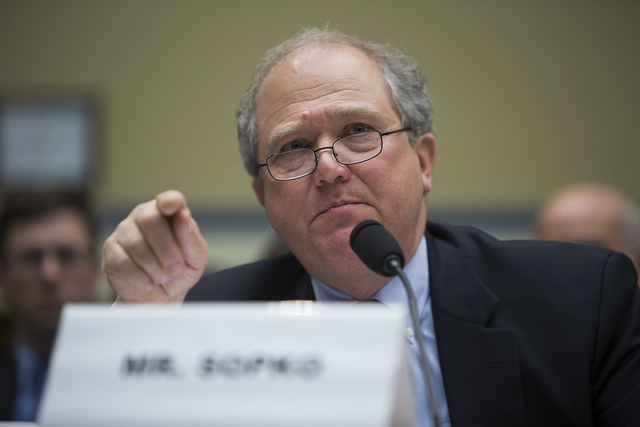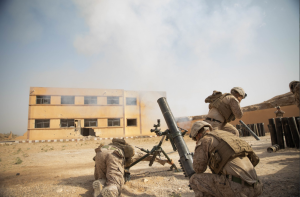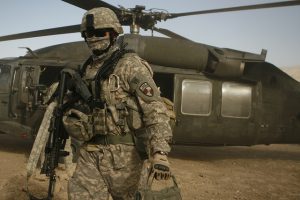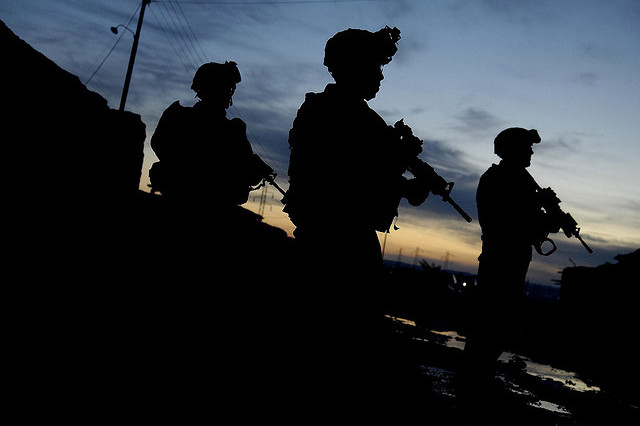by Derek Davison
The office of the Special Inspector General for Afghanistan Reconstruction (SIGAR) released its quarterly report on the progress of the War in Afghanistan this week, accompanied by a disturbing note from its head, John Sopko:
This quarter, the Department of Defense (DOD) instructed SIGAR not to release to the public data on the number of districts, and the population living in them, controlled or influenced by the Afghan government or by the insurgents, or contested by both. SIGAR has been reporting district-control data since January 2016, and later added estimates of population and land-area control reported by DOD. As shown in Appendix E of this quarterly report, SIGAR was informed this quarter that DOD has determined that although the most recent numbers are unclassified, they are not releasable to the public.
After facing some backlash for blocking the release of unclassified information, the Pentagon backtracked, blaming “human error” for the “unnecessary” restriction. If so, then it was a very coincidental error. It just so happened to obscure the fact that, a year into the “tough on terror” Trump administration and several months after Donald Trump announced his “new” Afghan War strategy—including stepped-up American airstrikes against the Taliban and Islamic State (IS or ISIS)—the situation on the ground in Afghanistan is virtually unchanged according to the Defense Department’s own estimates.
Perhaps someone at the Pentagon or in the Operation Resolute Support chain of command genuinely erred in blocking the release of this information. Or perhaps the Trump administration decided that the American people no longer have a right to know how the longest war in American history is actually going—and only reversed course when called out. Either way, the incident brings to mind a number of other details that the American people ought to know about the situation in Afghanistan.
Terrorism Is Unabated
Despite the Trump administration’s plan to increase military pressure on the Taliban until it gives up violence and comes to the bargaining table, the past year has seen some of the deadliest terror attacks yet in the Afghan War. Kabul, which lies within the 56 percent of the country controlled by the government, has seen several devastating attacks:
- In March of last year, gunmen stormed the Sardar Daud Khan hospital in the Afghan capital, killing over 100 people during a six-hour-long attack. IS claimed credit for the attack, but there is evidence to suggest that it was actually carried out by the Taliban’s ultra-violent Haqqani faction.
- Last May, over 150 people were killed when a truck bomb exploded in an area of Kabul that contains several foreign embassies and government buildings. The explosion apparently ignited a nearby fuel truck, raising the casualty level substantially. No group has claimed responsibility for this attack, but again the Haqqani Network is suspected of perpetrating it.
- In December, over 50 people were killed in a bombing that targeted a Shia cultural center in the city, an attack that was claimed by IS.
- In mid-January, around 40 people were killed when gunmen seized control of the Intercontinental Hotel in Kabul and engaged in a 12-hour battle with police. Here, too, the Haqqani Network is suspected of involvement.
- On Saturday, more than 100 people were killed when an ambulance packed with explosives blew up in a crowded part of Kabul. The Taliban claimed credit for this attack.
- Two days later, gunmen attacked the Marshal Fahim National Defense University in Kabul, killing 11 people, in an attack claimed by IS.
The university attack highlights an increasing problem for Afghanistan. In addition to the war between the government (and the U.S.) and the Taliban, the Afghan people are increasingly threatened by a morbid competition between the Taliban and IS to see who can inflict more carnage. This competition has included a recent IS attack on the offices of the Save the Children charity in Jalalabad. Despite the use of giant American bombs, the situation only seems to be getting worse.
Prospect of Negotiations More Remote
In mid-January, the Taliban sent representatives to Islamabad for “exploratory talks” with representatives of an unnamed Afghan politician regarding the possibility of resuming peace negotiations with Kabul. That sign of progress was all but wiped out by the ambulance bombing. Shortly after the bombing, Donald Trump appeared to close off the idea of negotiations altogether, telling representatives from the United Nations Security Council, and reporters, that “we don’t want to talk with the Taliban.”
Though Trump frequently says things that don’t come to pass, there seems—for now at least—to be a renewed desire on his part to win a war that America has, over the past 16-plus years, amply demonstrated that it cannot win.
Civilian Deaths, Systemic Child Sexual Abuse, and Opium Production
The Pentagon also prevented SIGAR from releasing civilian casualty figures for the first time, but the trend as of the watchdog’s last quarterly report, in October, was not good. Though overall civilian casualties in Afghanistan were down slightly in the first nine months of 2017 as compared to 2016 and 2015, they were still among the highest such figures recorded since 2009. Moreover, the proportion of those casualties caused by U.S. and Afghan airstrikes has gone up considerably since the new Trump plan went into effect. Airstrikes were responsible for 50 percent more civilian casualties in 2017 than in 2016.
Another SIGAR report, concluded last June but only released in January, confirmed what a New York Times investigation had already uncovered in 2015—that in its dealings in Afghanistan, the United States collaborates with serial child abusers:
On 5,753 occasions from 2010 to 2016, the United States military asked to review Afghan military units to see if there were any instances of “gross human rights abuses.” If there were, American law required military aid to be cut off to the offending unit.
Not once did that happen.
That was among the findings in an investigation into child sexual abuse by the Afghan security forces and the supposed indifference of the American military to the problem, according to a report released on Monday by the Special Inspector General for Afghan Reconstruction, known as Sigar.
One of the oft-cited justifications for continuing to prosecute the Afghan War is Afghanistan’s role as a major global supplier of opium. Drug cultivation has become a major source of revenue for the Taliban and has fueled many of the unaccountable militia groups that control parts of the Afghan countryside. The U.S. has put considerable money behind programs to encourage Afghan farmers to stop cultivating poppies, and eradicating poppy production has been one of its war aims. Nevertheless, Afghan opium production was higher than ever in 2017, more than double what it was in 2016. Because of the poppy’s important role in the rural Afghan economy, there’s little the U.S. can do to reduce its production short of collapsing that rural economy and thereby increasing popular support for the Taliban.
Things May Be Even Worse
Although the DOD and SIGAR say that the Afghan government controls around 56 percent of the country, a BBC investigation conducted between August and November of last year painted a much grimmer picture of conditions there. It found that, of Afghanistan’s 398 administrative districts, only 122 of them could be said to contain no Taliban presence at all. This means that the Taliban threaten nearly 70 percent of the country’s districts. And many of the 122 districts that do not have a Taliban presence are nonetheless, like Kabul, frequently visited by Taliban violence. IS, which only has a presence in 30 Afghan districts, has still demonstrated an ability to carry out attacks all over the country.
The more violence is visited on the Afghan people—especially in Kabul which is supposed to be the most secure city in the country—the more the Afghan people are questioning the viability of their own government and the efficacy of the ongoing U.S. mission there. If the U.S. and the Afghan government lose their remaining legitimacy with the Afghan people, the war effort will suffer even more than it already has.
Of course, to say that the American people ought to be aware of these facts is to suggest that they’re somehow being prevented from learning them, which isn’t true. Pentagon efforts to suppress information about the course of the war notwithstanding, all of these stories have been reported in the U.S. media. And yet the Afghan War seems almost completely removed from public consciousness. Americans are not bombarded with stories about Afghanistan on a regular basis. The war likely has only minimal impact on the daily lives of average Americans. Perhaps the issue isn’t that Americans don’t know what their military is doing in Afghanistan, it’s that, after more than 16 years at war, they simply don’t care.
Photo: John Sopko (SIGAR via Flickr).






Feb 8, 2009, General Petraeus: “…Although there have been impressive achievements in Afghanistan since 2001, the security situation has deteriorated markedly in certain areas in the past two years. Reversing that trend is necessary to improve security for the population, to permit the conduct of free and fair elections in August, and to enable progress in other important areas.”
So then President Obama increased the US troop level by 70,000, and later went on to say the war was over, and withdrew most of the troops. All with little effect. So now the US is sending a few more troops, and dropping lots of bombs which merely serves to kill and destroy …as nation-building! Actually it serves the anti-US forces by encouraging recruits to resistance of the US and its puppet government in Kabul.
As for the American people, they have no input in the process, zero, in a supposed democracy, but not really, so why should they care.
The cost of staying appears low. No reason to give the Jihadis a victory. If no end is in sight, why don’t they give up?